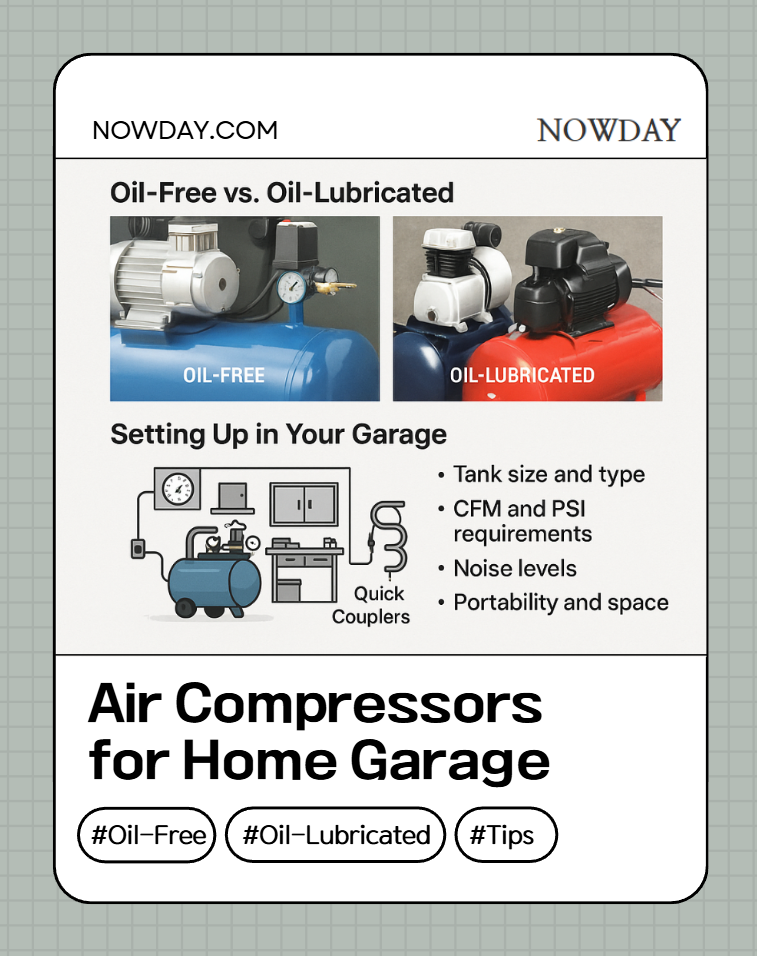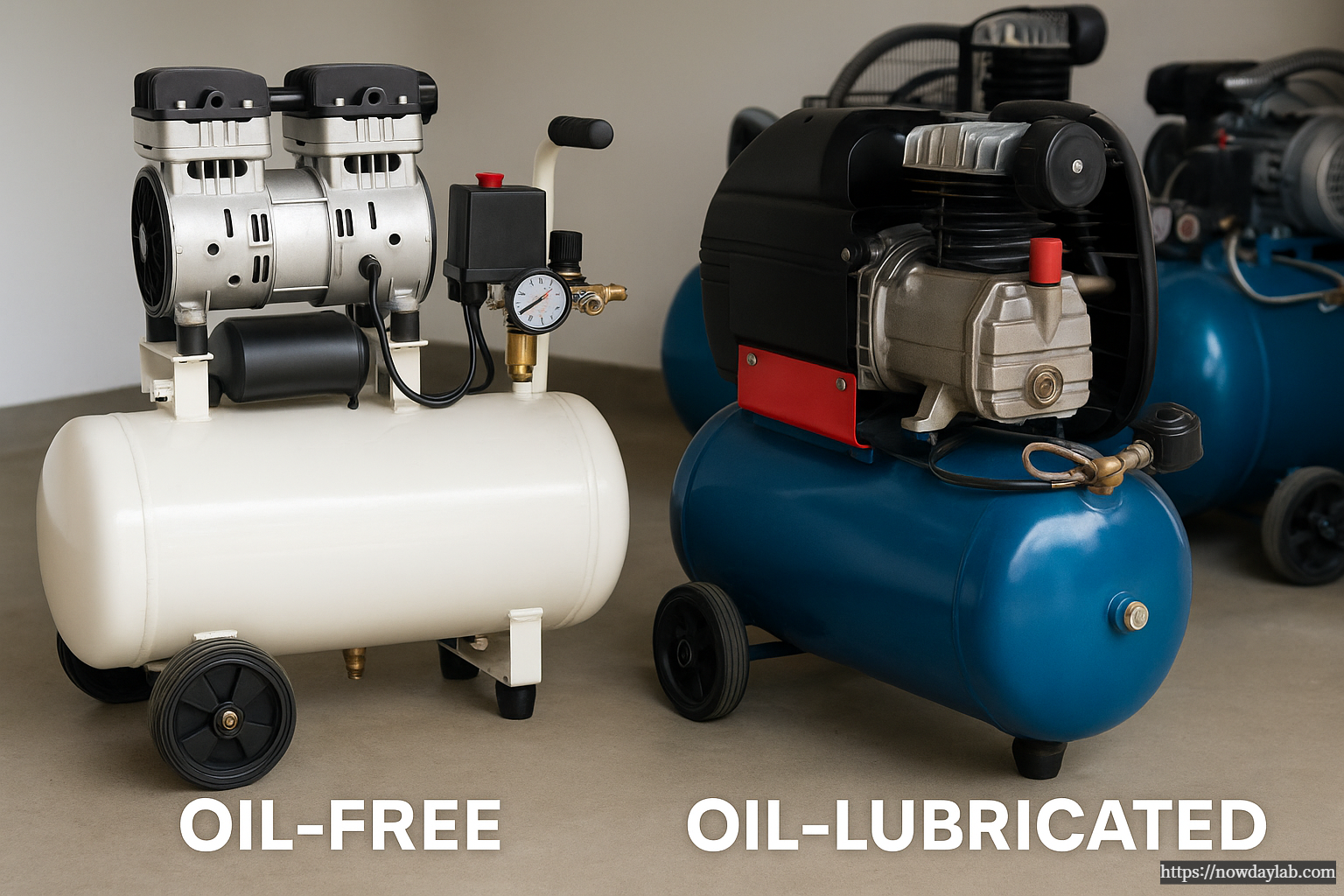
1. Introduction
Every garage guy hits this question at some point — “What size air compressor do I actually need?”
You look online, and everyone says “bigger is better.”
But here’s the truth from someone who’s actually used them on the floor — too big, and you’re wasting power; too small, and your tools choke halfway.
It’s all about air demand (CFM) and duty cycle, not just the tank size on the label.
2. The Basics – How Air Compressors Work

Air compressors take in ambient air, pressurize it in a tank, and deliver it to tools through a regulated outlet.
Simple, right? But performance depends on three key specs:
| Term | Meaning | What It Tells You |
| PSI (Pressure) | Pounds per square inch | How much pressure it can store/deliver |
| CFM (Flow) | Cubic feet per minute | How much air it delivers at a set pressure |
| Tank Size (Gal) | Gallons | How long you can work before the pump cycles |
If your tool needs 5 CFM at 90 PSI, and your compressor does 3 CFM — it’ll constantly run and overheat.
So, matching tool requirements is the first rule of compressor buying.
3. Oil-Free vs Oil-Lubricated Compressors

You’ll see these two everywhere:
| Type | Pros | Cons |
| Oil-Free | Low maintenance, lighter, cheaper | Noisy, shorter lifespan |
| Oil-Lubricated | Quieter, more durable, better cooling | Heavier, needs oil checks |
For casual DIY use (nail guns, tires, cleaning), oil-free is fine.
If you’re painting, wrenching, or running air tools daily, go with an oil-lubricated cast iron pump — the old-school ones last decades.
4. How Big Is Big Enough?
Here’s the real-world sizing cheat sheet from shop experience:
| Usage Type | Recommended Size | Example Tools |
| Tire Inflation, Blowing Dust | 2–3 CFM @ 90 PSI, 4–6 Gal | Air duster, inflator |
| Nail Gun / Stapler | 3–4 CFM @ 90 PSI, 6–10 Gal | Framing nailer, brad gun |
| Impact Wrench / Ratchet | 5–8 CFM @ 90 PSI, 20–30 Gal | Auto repair tools |
| Paint Sprayer / Sandblaster | 10–15 CFM @ 90 PSI, 60+ Gal | Bodywork, painting |
So before you grab that shiny 60-gallon monster, ask: “Do I really need 12 CFM?”
Most home garages run fine with a 20–30 gallon unit if you manage tool timing and rest cycles.
5. Air Distribution Setup

A clean setup saves headaches later.
Use 3/8" or 1/2" air lines, a moisture separator, and a pressure regulator near the tool point.
If you skip the separator, moisture will destroy your air tools and paint jobs.
And never — never — run PVC for compressed air. It can shatter like glass.
Go for rubber hose, copper, or aluminum tubing.
6. Safety & Maintenance Tips
- Drain the tank daily. Water builds up fast and corrodes from inside.
- Check relief valve function. It’s the only thing stopping an overpressure accident.
- Keep oil levels in check. Overfilled oil can block air flow.
- Replace filters every few months.
For most home users, compressors fail not from overuse but from neglect.
7. Conclusion
If you’ve got a garage, an air compressor is one of the best investments you’ll make.
Get one that matches your tools, set it up right, and it’ll outlast half the stuff you plug in.
The trick isn’t “how big,” it’s how balanced your setup is.
Bottom line: Don’t buy the biggest tank — buy the right airflow.
Flange Types and Their Applications – Weld Neck, Slip-On, Blind, Socket Weld, Threaded, Lap Joint
Flanges may look simple, but each type has a specific role in how a piping system handles pressure, temperature, and vibration. Using the wrong flange type can lead to leaks, misalignment, or even catastrophic failure.This guide explains the most common fl
www.nowdaylab.com
How Industrial Filters Work: Cartridge vs. Bag Type Explained
IntroductionIndustrial filtration is one of the most overlooked yet critical processes in manufacturing. Whether you are dealing with chemicals, semiconductor ultrapure water, or food processing, filtration determines the purity, efficiency, and lifespan o
www.nowdaylab.com
'INDUSTRIAL ENGINEERING > Filtration Systems' 카테고리의 다른 글
| How Industrial Filters Work: Cartridge vs. Bag Type Explained (0) | 2025.11.02 |
|---|
